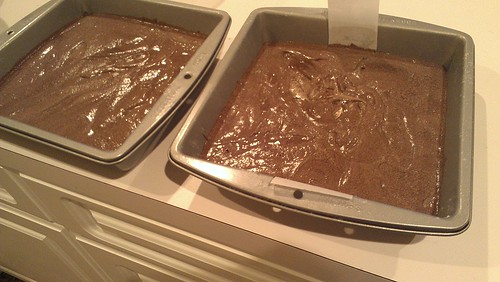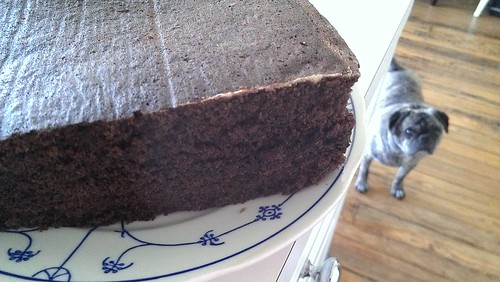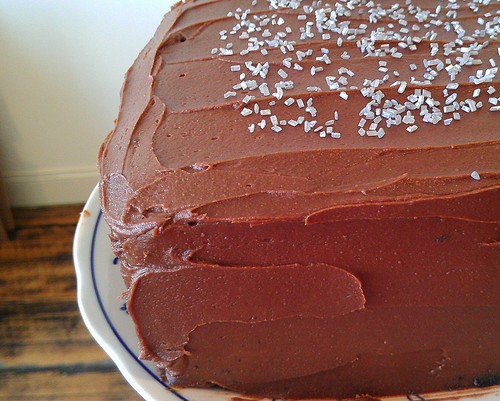Wellesley Fudge cake--a deeply decadent chocolate cake topped with a slab of fudge frosting--seems an unlikely sweet to associate with the prim-and-proper ladies of Wellesley (the college featured in the classic feat of cinema Mona Lisa Smile).
Clearly by the popularity of this recipe, it seems that those young ladies had as voracious an appetite for the sweet stuff as they did for knowledge. But to really look at the origins of this cake, we’ve got to rewind a little bit, to the invention of fudge itself.
Fudge, that semi-soft candy made from butter, sugar, and various flavorings (very commonly chocolate) is an american-ized version of french bonbons and creams, and it became popular in the US in the early 1900s. The Oxford English Dictionary suggests that the name is perhaps derived from the word “fadge”, which is an old-timey term for “to fit pieces together”. Of course, not to confuse you, but an Irish dish called “Fadge” does exist, but it is actually an apple potato cake, traditionally served at Halloween.
As an interesting side note, the word “fudge” referring to a cheat or hoax dates to the 1830s, before the candy was popular--but this may explain how the name was assigned to the candy, too.
You see, those young college ladies would use the sweet stuff as their excuse to stay up late: candy-making was an acceptable activity, and they would use it as an excuse to stay up late, ostensibly to talk about boys and other forbidden subjects. “Nearly every night at college,” said the Vassar girl, “some girl may be found somewhere who is making ‘fudges’ or giving a fudge party.” The timing seems to work out: the word “fudge” for a confection showed up as early as the 1890s, and by 1908 the term was commonly used in association with women’s colleges.

A 1909 cookbook produced by Walter Baker & Co. (producer of Baker’s chocolates) includes three different recipes for fudge, each just slightly different and named, respectively, after Vassar, Smith, and Wellesley colleges.
In fact, there is a letter in the Vassar archives which says,
“Fudge, as I first knew it, was first made in Baltimore by a cousin of a schoolmate of mine. It was sold in 1886 in a grocery store...I secured a recipe and in my first year at Vassar, I made it there--and in 1888 I made 30 pounds for the Senior auction, its real introduction to the college, I think.”
So why would it proliferate, and be adapted to an even richer and more over the top treat, the decadent Wellesley Fudge Cake, at this particular school? Perhaps because it was such a forbidden pleasure there. An 1876 circular to parents states that the college refuses to accept students who are broken down in health, maintaining that a proper diet is key for proper learning, and that “we have therefore decided not to receive any one who will not come with the resolution to obey cheerfully all our rules in this respect, and pledged in honor neither to buy nor receive in any manner whatsoever any confectionery or eatables of any kind not provided for them by the College.” Further, the founder of Wellesley College held that, “pies, lies, and doughnuts should never have a place in Wellesley College”. Well, naturally it would take off here: it tasted positively sacre-licious!
By 1913, fudge and fudge cakes were was common on the tea-room menus surrounding the college.
Every few decades the cake enjoys a renaissance; a little fussy to make in that it requires a bit of candy-making prowess, it is astoundingly easy to eat. The confection was bound for success too: soon, it was even featured prominently as
Some versions call for an unfrosted cake; others, which I favor, feature a double dose of chocolate, the base of which is brownie-like, coated with a more fudge-like frosting.
Note: Traditional recipes called for “thick sour milk”; I'm not quite sure what that even is, so this recipe employs buttermilk. After testing another traditional recipe with some help by Java Cupcake, I find this a superior cake.
The recipe that finally ended up tasting best? This one, lightly adapted from the geniuses at Cook's Country Magazine. Their original version appears in the book Cook's Country Blue Ribbon Desserts.
Wellesley Fudge Cake
Adapted from Cook's Country Blue Ribbon Desserts
Cake
- 2 1/2 cups all-purpose flour
- 2 t. baking soda
- 1 t. baking powder
- 1/2 t. salt
- 3/4 c. hot water
- 1/2 c/ Dutch-processed cocoa powder (I used Hershey's Special Dark which also works fine)
- 16 T. (2 sticks) unsalted butter, cut into 16 pieces and softened
- 2 c. granulated sugar
- 2 large eggs
- 1 c. buttermilk, room temperature
- 2 t. vanilla extract
Frosting
- 1 1/2 c. packed light brown sugar
- 1 c. evaporated milk
- 8 T. (1 stick) unsalted butter, cut into 8 pieces and softened
- 1/2 t. salt
- 8 oz. bittersweet chocolate, chopped
- 1 t. vanilla extract
- 3 c. confectioners’ sugar, sifted
To make the cake:
- Adjust an oven rack to the middle position and heat the oven to 350 degrees. Grease and flour two 8-inch square baking pans, then line the bottoms with parchment paper. Combine the flour, baking soda, baking powder and salt in a bowl. Set aside.
- In a small bowl, whisk the hot water and cocoa together until smooth and set aside. In a large bowl, beat the butter and granulated sugar together with an electric mixer on medium-high speed until light and fluffy, 3-6 minutes. Beat in the eggs, one at a time, until incorporated. Mix in one-third of the flour mixture, followed by 1/2 cup of the buttermilk. Repeat with half of the remaining flour mixture and the remaining 1/2 cup buttermilk. Add the remaining flour mixture and mix until combined. Reduce the mixer speed to low and slowly add the cocoa mixture until incorporated.
- Give the batter a final stir with a rubber spatula to make sure it is thoroughly combined. Scrape the batter into the prepared pans, smooth the tops, and gently tap the pans on the work surface to settle the batter. Bake the cakes until a toothpick inserted in the center comes out with a few crumbs attached, 25-30 minutes, rotating the pans halfway through baking. Let the cakes cool in the pans for 15 minutes. Run a small knife around the edges of the cakes, then flip them out onto a wire rack. Peel off the parchment paper, flip the cakes right side up, and let cool completely before frosting, about 2 hours. (The cakes can be wrapped tightly in plastic wrap and stored at room temperature for up to 2 days.)
- To make the frosting: Stir together the brown sugar, 1/2 cup of the evaporated milk, 4 tablespoons of the butter, and salt in a large saucepan and cook over medium heat until small bubbles appear around the edge of the pan, 4-8 minutes. Reduce the heat to low and simmer, stirring occasionally, until large bubbles form and the mixture has thickened and turned deep golden brown, about 6 minutes. Transfer to a large bowl. Stir in the remaining 1/2 cup evaporated milk and remaining 4 tablespoons butter until the mixture has cooled slightly. Add the chocolate and vanilla and stir until smooth. Whisk in the confectioners’ sugar until incorporated. Let the frosting cool to room temperature, stirring occasionally, about 1 hour.
- Line the edges of a cake platter with strips of parchment paper to keep the platter clean while you assemble the cake. Place one of the cake layers on the platter. Spread 1 cup of the frosting over the cake, right to the edges. Place the second cake layer on top, press lightly to adhere, and spread the remaining frosting evenly over the top and sides of the cake. Refrigerate the cake until the frosting is set, about 1 hour. Remove the parchment strips from the platter before serving.

